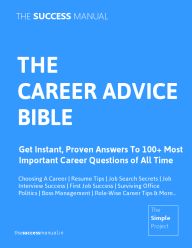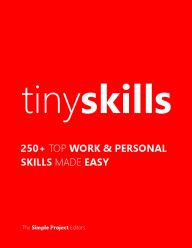On February 16, 2025 By thesuccessmanual Topic: Remarkable, Book summary, Quotes, Mba
This is simple decision making 101: The best advice you need to know.
This guide belongs to 100 Ways To Be Being Remarkable Series, a special project that brings you business and self-development advice from The Success Manual.
The specific executive task.
– Peter Drucker
In the business world, the rearview mirror is always clearer than the windshield.
- Warren Buffett
If you see a guy beatin’ his dog, whip his ass on the spot.
-Forrest Gump
Society is always taken by surprise at any new example of common sense.
Ralph Waldo Emerson
The Key to everything is patience. You get the chicken by hatching the egg.
- Arnold Glasow
I believe in instinct, not reason. When reason is right, nine out of ten it is impotent, and when it prevails, nine out of ten it is wrong.
- A.C. Benson
You have to do stuff that average people don’t understand, because those are the only good things.
- Andy Warhol
If you it right 51% of the time you will end up a hero.
- Alfred P. Sloan, Jr.
Nothing is more terrible than activity without insight.
- Thomas Carlyle
We want every employee to be a businessperson.
- Ralph Stayer
Never use the excuse of following orders as the rationale for following a poor course of action.
- Roger Meade
decisive, a.
1. having the power or quality of setting a dispute, question, doubt, contest, event, etc.; final; conclusive.
2. marked by decision or prompt determination; as, a decisive character.
Syn. – decided, final, conclusive, unquestionable, unmistakable, positive.
FIVE CREATIVE THINKING STYLES FOR BUSINESS
1. The Seer: Seeing an internal image of the idea. Bill Gates saw a PC on every desk.
2. The Observer: They pay attention to small things and get big ideas from those details. Sony’s Akio Morita saw children lugging heavy stereo equipment and asked himself….
3. The Alchemist: Uses the world around him to come up with new ideas. They often find breakthroughs by create g analogies of the natural world.
4. The Fool: He knows how to “invert” problems, persevere when the going gets tough and isn’t afraid to pursue absurd notions.
5. The Sage: He takes complicated information, synthesizes it quickly and comes up with a great idea.
- Annette Moser-Wellman, ‘The Five faces of Genius’ and “Creative Thinking styles to succeed at work”
Act well at the moment, and you have performed a god action to all eternity.
- Johann Kaspar Lavater
(And do it now! There may be a law against it tomorrow.)
How to Optimize Simple Decisions
1. Define the problem.
2. Define the time frame in which the decision must be made.
3. Explore options for resolving the problem.
4. Eliminate the options that are unrealistic.
5. Examine the consequences of each option.
Write down the advantages and disadvantages (pros and cons).
6. Rate or "weigh the pros and cons on a scale from 1 to 10.
1=least important, 10=most important
7. Determine which option is in your best interest.
How to Optimize Complex Decisions
1. Decide upon what you most want to achieve.
2. Define the time frame in which the decision must be made.
3. Make a list of the most important factors (criteria) that will influence your decision.
4. Rate your criteria.
5. Rate how well your first options meets your criteria.
6. Multiply the ratings for your criteria (Step 4) by the ratings for how your first option meets the criteria (Step 5)
7. Determine the total score.
8. Complete Steps 6 and 7 for your other options.
9. Decide on your best option based on the highest score.
- Adapted from the book ‘Optimal Thinking: How to Be Your Best Self’ by Rosalene Glickman
CONTROL YOUR CHOICES
1. Choose when to choose
2. Be a chooser, not a picker
3. Satisfied more and maximize less
4. Think about the opportunity cost of opportunity costs
5. Make your decisions non-reversible
6. Practice an "Attitude of Gratitude"
7. Regret less
8. Anticipate adaptation
9. Control expectations
10. Control Social comparison
11. Learn to love constraints
- Adapted from the book ‘Paradox of Choice: Why More Is Less’ by Barry Schwartz
QBQ: THE QUESTION BEHIND THE QUESTION
1. Landing the plane with the stopped engine "differently"
2. Solutions to procrastination
Stop asking externally focused questions that begin with "when"
instead, ask QBQs, like. . .
What solution can I provide
How can I more creatively reach the customer
What can I do to find the information to make a decision
3. Personal accountability
Comes from questions that begin with the words "What" or "How" and contain the word "I"
to make a qbq action-focused, add verbs such as "do", "make", "achieve", and "build"
add "can" or "will" and "now" or "today"
results in
"What can I do right now?"
"How can I make a difference today?"
4. Managers don't change people
Change only comes from the inside as a result of decisions made by the individual
5. Integrity
Being what I say I am by acting in accordance with my words
6. Serenity prayer
Old: "God grant me the serenity to accept the things I cannot change, the courage to change the things I can, and the wisdom to know the difference."
qbq: "God grant me the serenity to accept the things I cannot change, the courage to change the one I can, and the wisdom to know it's me."
7. QBQs
1. All QBQs begin with "What" or "How", not "Why", "When", or "Who."
2. All QBQs contain the personal pronoun "I", not "They", "Them", "We", or "You".
3. All QBQs focus on action.
4. The spirit is personal accountability. No more victim thinking, procrastination, or blame. I can only change me. I will take action.
Not "What can I do to make you change?"
Not "How can I avoid responsibility?"
Not "What action can I take right now to do the wrong thing?"
Not "Who can I blame today?"
- Adapted from the book ‘QBQ! The Question Behind the Question’ by John G. Miller
If you liked this article, please bookmark it on Delicious or share on Twitter. Thanks, friends. Follow us on Twitter.
We don't recommend any other guide than our very own The Success Manual - Encyclopedia of advice to 130 most important skills.

